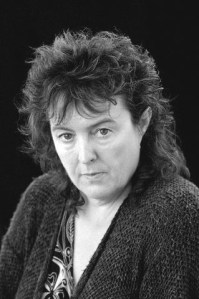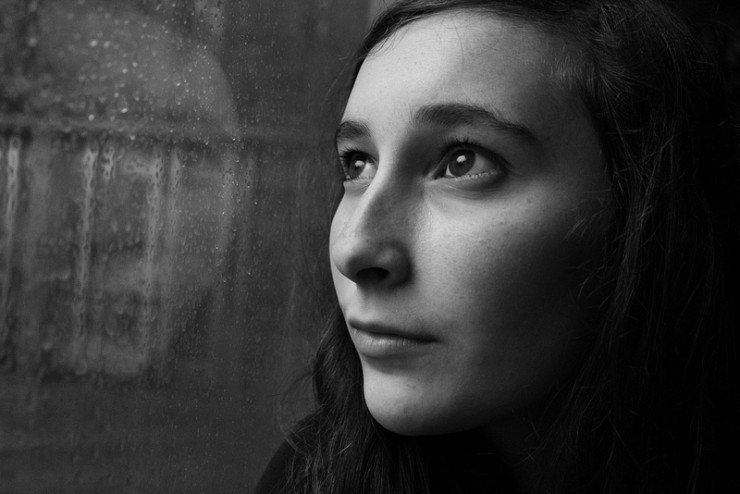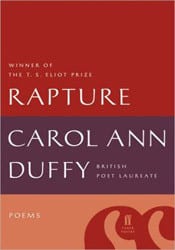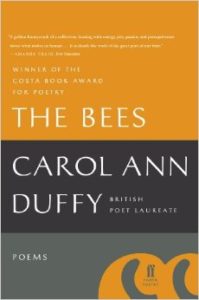It’s a long and distinguished list, and includes Edmund Spenser, Ben Jonson, John Dryden, William Wordsworth, Alfred Lord Tennyson, John Masefield, Sir John Betjeman, and Ted Hughes. Until 2009, the poets who served as British poet laureates were all men.
And then came Carol Ann Duffy.
A Scot, Duffy is a poet, playwright, children’s author, and anthology editor. Her first collection was published in 1973. Some 10 collections later, she won the T.S. Eliot Prize for Rapture (2005).
Rapture is a remarkable collection of love poems documenting the rise and eventual fall of a love affair. In Duffy’s case, this would have been a lesbian love affair; Duffy is not shy about her sexual orientation. (She was considered for the post laureate post in 1999 but deemed too controversial at that time.)
The poems in Rapture, however, transcend any of the categories we might assign them. They could just as easily apply to any love affair. Reading them is an exercise in experiencing beauty and passion; Duffy’s language is often simple but it is invariably powerful.
When did your name
change from a proper noun
to a charm?
Its three vowels
like jewels
on the thread of my breath.
Its consonants
brushing my mouth
like a kiss.
I love your name.
I say it again and again
in this summer rain.
I see it,
discreet in the alphabet,
like a wish.
I pray it
into the night
till its letters are light.
I hear your name
rhyming, rhyming,
rhyming with everything.
The Bees (2014) was Duffy’s first collection since her Poet Laureate appointment, and it was met with mixed reactions. Some critics, like The Guardian, generally praised it; others, like the Evening Standard, were more ambivalent.
It’s a decidedly different collection from Rapture. It includes a few “poet laureate” poems on events and locations in Britain, but the poems demonstrate Duffy’s strengths as a poet, and particularly her use of metaphor, interior rhyme, and use of occasional alliteration (considered a fault by the review in the Standard). Yet the poems are eminently approachable, and suggest why Duffy is a popular poet in Britain (perhaps for much the same reason Billy Collins remains popular in the United States).
When I went to read
the bulletin about broken holy beads
to the bees,
the beads were the bees themselves…
(though once I’d been
a bairn with a bamboo-cane,
keen to follow the beekeeper
down to the hives, tap and tell
all news – whose bride, who lied, who’d died –
and had seen the bees as a rosary, girdling,
garden by garden, the land;
or had heard their hard devotional sound
in the ears of flowers
as I barely breathed, beheld
their bold, intimate touch…)
for a scattered bracelet of bees
lay on the grass by their bungled hive.
So how could I tell the bees?
Black blood in the sea.
Corn buttercup brought to its knee.
No honey for tea.

Carol Ann Duffy
She plays with alliteration (bees and beads) and rhyme (the bride who lied and died), while pushing powerful images – a baby (bairn) with a cane, the bees’ “devotional sound in the ears of flowers, ” and a “scattered bracelet of bees.” When I read it aloud, I kept hearing the sounds of two particular letters: b and d.
In addition to Rapture and The Bees, Duffy’s poetry collections include Fleshweathercock and Other Poems (1973); Fifth Last Song (1982); Standing Female Nude (1985); Thrown Voices (1986); Selling Manhattan (1987); The Other Country (1990); Mean Time (1993); Selected Poems (1994); The Pamphlet (1998); The World’s Wife (2001); New Selected Poems (2004); and Feminine Gospels (2005). Her Christmas poems include Another Night Before Christmas (2006); Mrs. Scrooge (2009); and Wenceslas: A Christmas Poem (2012). She’s also written plays and works for children, edited several anthologies, and with Eliana Tomkin wrote a CD of 10 songs entitled Rapture that followed the poetry collection.
Duffy is one powerful poet with a distinguished body of work. I can only hope her duties as Poet Laureate don’t lengthen the time until her next collection.
Related:
Sheer Poetry, the site Duffy and other poets have created to provide poetry and resources for teachers at all levels (primary to university) and the general reader.
Duffy’s listings at the Poetry Foundation and British Council on Literature.
Photo by martinak15, Creative Commons, via Flickr. Post by Glynn Young, author of the novels Dancing Priest and A Light Shining, and Poetry at Work.
__________________________

“I require all our incoming poetry students—in the MFA I direct—to buy and read this book.”
—Jeanetta Calhoun Mish
- Longfellow’s “Paul Revere’s Ride”: Creating a National Legend - April 17, 2025
- Poets and Poems: Katie Kalisz and “Flu Season” - April 15, 2025
- Poets and Poems: Michelle Ortega and “When You Ask Me, Why Paris?” - April 10, 2025



Bethany says
Those lines: “heard their hard devotional sound/ in the ears of flowers” are just gorgeous.
Glynn says
Bethany, thanks for the comment – and for reading the post.
Dr Pamela D Moorehead says
As a metaphysician, I see clearly you see life through vivid imagination of realities most minds are sometimes too serious or not lax enough. The metaphors which I love stimulated my imagination making me want to stretch toward the Heavens for the spirit of the word is upon you. I enjoy your work and will delight in you being the first woman to have such a page I shall cherish the opportunity.
Thank you for sharing you love of poetry with the world
Maureen says
I’ve been reading Duffy for quite a while. Her poetry appears frequently in The Guardian, which I think has the best arts coverage of any paper.
Nice introduction to TSP readers, Glynn.
shiranirajapakse says
All those critical of writers who use simple language really have no idea what amazing pieces of art a good writer can mold from simple everyday words. I find myself holding my breath in wonder every time I read Ms. Duffy’s poems.